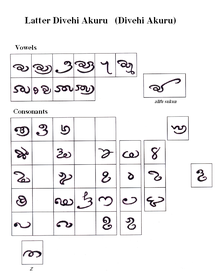Dhives Akuru
| Dhives Akuru 𑤝𑤱𑤩𑤴𑤬𑤽 𑤥𑤌𑤳𑤧𑤳(Dives Akuru), 𑤝𑤱𑤩𑤴𑤭𑤱 𑤥𑤌𑤳𑤧𑤳(Divehi Akuru) | ||
|---|---|---|
'Divehi Akuru' in modern Noto Serif Dives Akuru font | ||
| Script type | ||
Time period | 6th-8th centuries CE (earliest attestation) to late 19th century | |
| Direction | Left-to-right Unicode range |
|
The theorised Semitic origins of the Brahmi script are not universally agreed upon. | ||
| Brahmic scripts |
|---|
| The Brahmi script and its descendants |
This article needs attention from an expert in Maldives. See the talk page for details. (July 2012) |


Dhives Akuru, later called Dhivehi Akuru (meaning Maldivian letters) is a script formerly used for the Maldivian language. The name can be alternatively spelled Dives Akuru or Divehi Akuru using the ISO 15919 Romanization scheme, as the "d" is unaspirated.
History
Dhives Akuru developed from
Brahmi
script and thus was written from left to right.

Dhives Akuru was still used in some southern atolls along with
National Archives of Sri Lanka
in Colombo.
Bodufenvalhuge Sidi, an eminent Maldivian scholar, wrote a book called Divehi Akuru in 1959, prompted by then Prime Minister Ibrahim Nasir.[4]
Unicode
The Dhives Akuru script was added to Unicode version 13.0 in March 2020, with 72 characters located in the Dives Akuru block (U+11900–U+1195F):[5]
| Dives Akuru[1][2] Official Unicode Consortium code chart (PDF) | ||||||||||||||||
| 0 | 1 | 2 | 3 | 4 | 5 | 6 | 7 | 8 | 9 | A | B | C | D | E | F | |
| U+1190x | 𑤀 | 𑤁 | 𑤂 | 𑤃 | 𑤄 | 𑤅 | 𑤆 | 𑤉 | 𑤌 | 𑤍 | 𑤎 | 𑤏 | ||||
| U+1191x | 𑤐 | 𑤑 | 𑤒 | 𑤓 | 𑤕 | 𑤖 | 𑤘 | 𑤙 | 𑤚 | 𑤛 | 𑤜 | 𑤝 | 𑤞 | 𑤟 | ||
| U+1192x | 𑤠 | 𑤡 | 𑤢 | 𑤣 | 𑤤 | 𑤥 | 𑤦 | 𑤧 | 𑤨 | 𑤩 | 𑤪 | 𑤫 | 𑤬 | 𑤭 | 𑤮 | 𑤯 |
| U+1193x | 𑤰 | 𑤱 | 𑤲 | 𑤳 | 𑤴 | 𑤵 | 𑤷 | 𑤸 | 𑤻 | 𑤼 | 𑤽 | 𑤾 | 𑤿 | |||
| U+1194x | 𑥀 | 𑥁 | 𑥂 | 𑥃 | 𑥄 | 𑥅 | 𑥆 | |||||||||
| U+1195x | 𑥐 | 𑥑 | 𑥒 | 𑥓 | 𑥔 | 𑥕 | 𑥖 | 𑥗 | 𑥘 | 𑥙 | ||||||
| Notes | ||||||||||||||||
References
- Bell, H.C.P. Excerpta Maldiviana. Reprint 1922-1935 edn. New Delhi 1998.
- Bell, H.C.P. The Maldive islands. Monograph on the History, Archaeology and Epigraphy. Reprint 1940 edn. Male' 1986.
- Divehi Bahuge Qawaaaid. Vols 1 to 5. Ministry of Education. Male' 1978.
- Divehīnge Tarika. Divehīnge Bas. Divehibahāi Tārikhah Khidumaiykurā Qaumī Majlis. Male' 2000.
- Geiger, Wilhelm. Maldivian Linguistic Studies. Reprint 1919 edn. Novelty Press. Male' 1986.
- Gunasena, Bandusekara. The Evolution of the Sinhalese Script. Godage Poth Mendura. Colombo 1999.
- Romero-Frias, Xavier. The Maldive Islanders, A Study of the Popular Culture of an Ancient Ocean Kingdom. Barcelona 1999.
- Sivaramamurti, C. Indian Epigraphy and South Indian Scripts. Bulletin of the Madras Government Museum. Chennai 1999.
Citations
- ^ ISSN 0084-0084.
- ISSN 0044-8613.
- ^ Pandey, Anshuman (2018-01-23). Proposal to encode Dives Akuru in Unicode (PDF). Unicode. pp. 4, 70.
- ^ Sidi, Bodufenvalhuge (1959). "Divehi Akuru". Academia (in Divehi and English).
- ^ "Unicode 13.0.0". unicode.org. Retrieved 2020-02-06.
